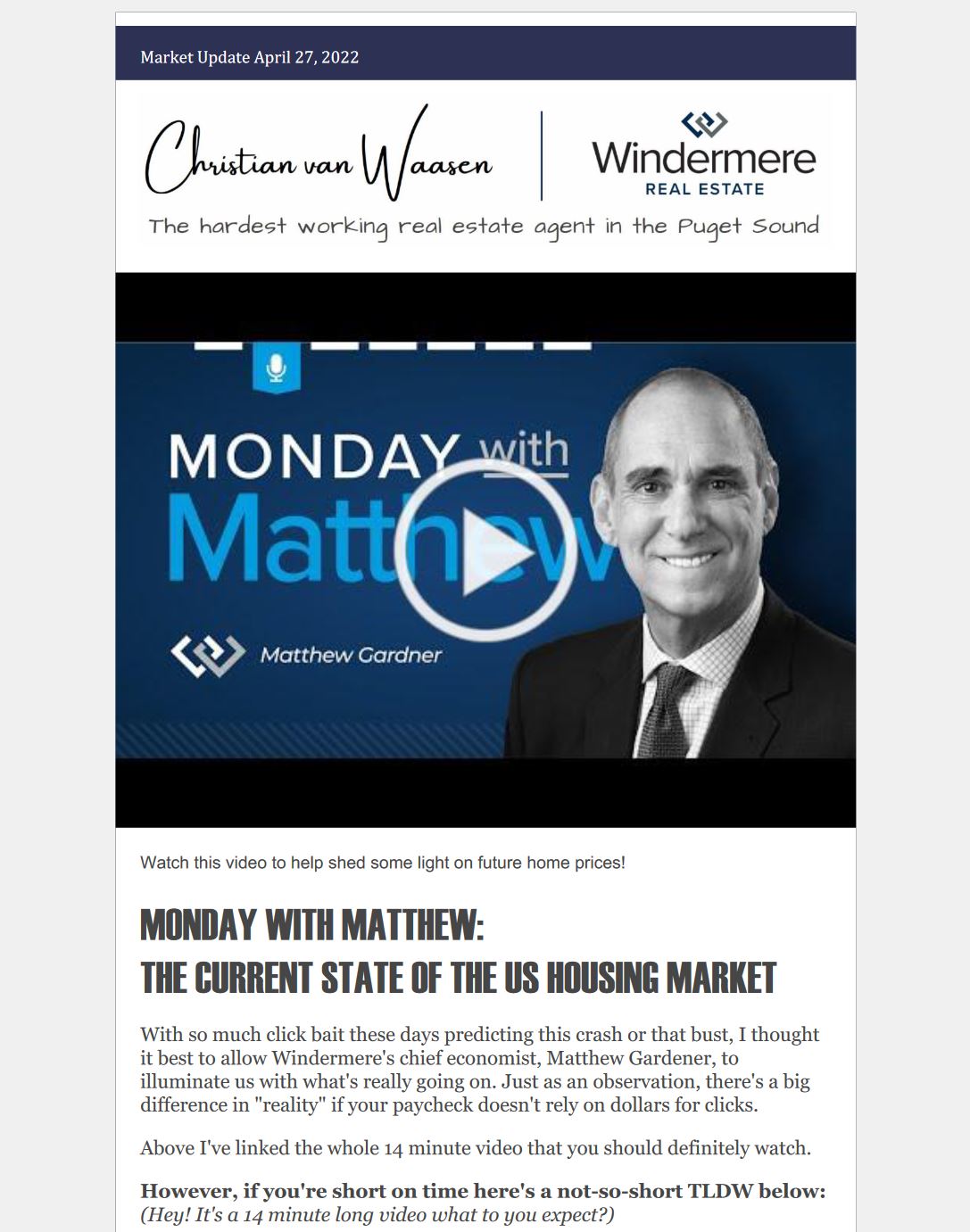
MONDAY WITH MATTHEW: THE CURRENT STATE OF THE US HOUSING MARKET
With so much clickbait these days predicting this crash or that bust, I thought it’s best to allow Windermere’s chief economist, Matthew Gardener, to illuminate us with what’s really going on. Just as an observation, there’s a big difference in “reality” if your paycheck doesn’t rely on dollars for clicks.
Above I’ve linked the whole 14-minute video that you should definitely watch.
However, if you’re short on time, here’s a not-so-short TLDW below:
(Hey! It’s a 14-minute-long video, what do you expect?)
With housing prices continuing to defy gravity, mortgage rates spiking, the Fed planning to raise interest rates significantly, the yield curve that’s keeping it nose just above water, and some becoming vocal that we’re going to be entering a recession sooner than later – it’s not at all surprising that people have begun wondering if the housing market will pull back significantly.
First, a little perspective:
- From 1990 to 2006, home prices rose 142% – or an annual 5.6%
- From 2006 to 2012, home prices drop 33%
- From 2012 to today, home prices have risen 131% – or an annual 8.6%
You may think that the current annual 8.6% rate, which exceeds the pace seen before the 2007-8 market crash, has some people concerned – but that isn’t what many people are scared of. It’s this:
At the start of 2022, mortgage rates were 3.11% – but over a brief 15-week period have shot up to 5.00% – and it’s this that has led some people to think that the market is about to implode.
It’s certainly human nature to think, “what goes up, must come down” – but is there any real reason to panic? Mr. Gardner doesn’t think so.
Over the past 30 years, there were periods when both mortgage rates and financing costs significantly rose – during these times, home prices still went up just over 5%. However, these increasing mortgage rates did have some negative impact on the real estate market; they lowered home sales and housing starts.
So, if we use history as an indicator, the current jump in mortgage rates will likely translate to “lower transactions rather than lower prices.”
Although rising financing costs reduced housing affordability, mortgage rates actually tend to rise during a period of economic prosperity. Which this comes rising wages – these certainly offset at least some impacts of rising mortgage rates.
While rates have risen dramatically in a short period (because they started from an historic low) the overall impacts are not yet very significant. The only time since 1968 that home prices have dropped on an annualized basis was in 2007 through 2009 and in 2011, and this was due to the massive increase homes for sale due to foreclosures spurred on by bad lending practices. Since current lending practice are strict and highly regulated, we aren’t faced with a surge of inventory. But even if we do see listing activity increase, there will be more than enough demand from would-be buyers. Mainly because owning real estate is a proven hedge against inflation.
Here’s why: most buyers have a mortgage, and a vast majority use fixed-rate financing. This is the hedge because even as consumer prices are rising, a homeowner’s monthly payments aren’t. They remain static and, more than that, their monthly payments actually become lower over time as the value of the dollar diminishes. Simply put, the value of a dollar in—let’s say 2025—will be lower than the value of a dollar today.
Additionally, inflation can actually stimulate the housing market. Home prices historically have grown at a faster pace than inflation. See graph below.
This chart looks at both the annual change in total CPI and the annual change in median U.S. home price going back to 1969. Other than when home prices crashed with the bursting of the housing bubble, for more than fifty years home price growth has outpaced inflation. And this means we are offsetting high consumer prices because home values are increasing at an even faster rate.
Additionally, interest rates on savings are pitifully low. Even the best rates of 0.5% – 0.7% still are significantly below the rate of inflation, meaning the dollars saved continue to lose value. It’s much better to put those dollars into real estate. Here is a summary bullet point list on why housing is such a great inflation hedge:
The Bottom line:
Mortgage rates are normalizing and are highly unlikely to be the cause of a market correction.
 Facebook
Facebook
 X
X
 Pinterest
Pinterest
 Copy Link
Copy Link


